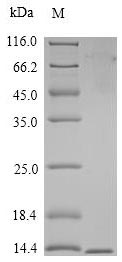Introducing our Recombinant Macaca fascicularis CD3G, specifically engineered for immunology research and applications involving the T-cell surface glycoprotein CD3 gamma chain. Derived from Macaca fascicularis (Crab-eating macaque or Cynomolgus monkey), this protein encompasses the extracellular domain with an expression region of 23-113aa, ensuring a high-quality product for your research needs.
Produced in a yeast expression system, our CD3G protein is equipped with an N-terminal 6xHis tag for straightforward purification and detection processes. With a purity greater than 90% as determined by SDS-PAGE, our recombinant protein is available in both liquid and lyophilized powder forms to suit your specific experimental requirements. Trust our precision-crafted Recombinant Macaca fascicularis CD3G to deliver consistent, reliable results for your immunology research.






